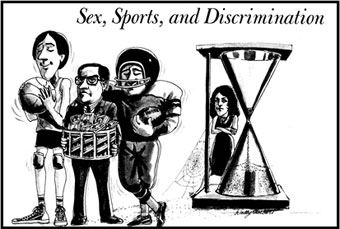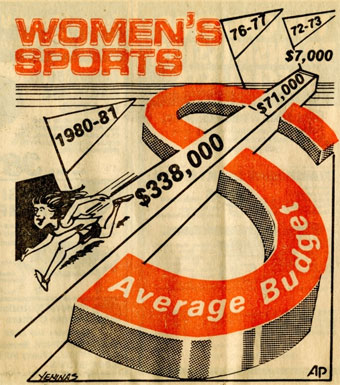Essential question
In what ways do political cartoons explain or capture public opinion?
"...we had to understand that there were three sexes in athletics: men, women and football players." – Margot Polivy, lawyer for the Association of Intercollegiate Athletics for Women (AIAW)
"Some believed that Title IX rules shouldn't apply to any sports that brought in money-mainly football and basketball- needed that money to pay for their coaches, scholarships, and travel. Forcing football programs to share their revenue from ticket sales and television broadcasts would damage premier programs"
Blumenthal, Karen. Let Me Play: The Story of Title IX: the law that changed the future for girls in America. New York: Atheneum Books for Young Readers, 2005. 87, 67. Print.
Have students analyze the following political cartoons and answer the accompanying questions. Then, read the excerpt on Money and Title IX.

Cartoon A

Cartoon B
Questions
- In cartoon A, what groups are represented?
- What symbols are associated with each group, and how do they reflect various perspectives?
- Based on the cartoonist's interpretation in cartoon A, what is the overall impression of Title IX.
- What is the message of Cartoon B?
- How is economics impacted by Title IX, and how is time a factor?
- How do the two cartoons differ in their portrayal of women?
Money and Title IX
The budgets provided for male and female sports do not have to be equal — after all, those football pads cost more than field hockey sticks. Budgets can indicate where there might be a problem, especially in areas where needs cost the same. Benefits provided must be equal. In other words, football equipment cannot be top-of-the-line while the field hockey team tapes together cheap, shoddy sticks.
Budget levels are especially important where the dollar limits set by the school cause unequal services. For example, a lack of a recruiting budget that results in few recruiting efforts for the women's program would be considered if the men's program has a large budget and, therefore, conducted a lot of recruiting.
A budget can also affect the number of athletes on a team. For example, a softball coach may only carry the minimum number of players because the budget for the team is not enough to supply the equipment, uniforms and travel costs for more athletes. At the same time, the baseball team may have a full roster with plenty of players on the bench because their budget is much larger.
So that time-honored excuse, "we don't have the money," is not a good enough answer. If the men's athletic program receives greater benefits than the women's, the institution has three choices: increase the benefits for the women, decrease the benefits for the men or some of both. Simply telling the women there is not enough money does not relieve the institution of its responsibilities under Title IX.
Ability to generate revenue also is not a legitimate reason for discrimination. In Favia v. Indiana University of Pennsylvania, Judge Maurice B. Cohill, Jr., wrote in his opinion, "We are also sympathetic with the fact that the football team represents a large portion of the dominance of men's teams over female teams at IUP. Football is a high-profile sport; it generates money through ticket sales and undoubtedly heightens the interest of students, alumni and potential students in the university. As a dangerous sport, it is also expensive. Unfortunately, however, Title IX does not provide for any exception to its requirements simply because of a school's financial difficulties. In other words, a cash crunch is no excuse."
Extension
Using charts A, B, and C compare and contrast the statistics for high school and college. Possible questions: Where did women have the greatest gains? In what areas was women's progress lacking?
- Chart A View now or open the PDF version (0.1MB)
- Chart B View now or open the PDF version (0.2MB)
- Chart C View now or open the PDF version (0.2MB)
The following document was created by a U.S. History II teacher, who piloted this module, to help students analyze the above Title IX political cartoon and graphs.
